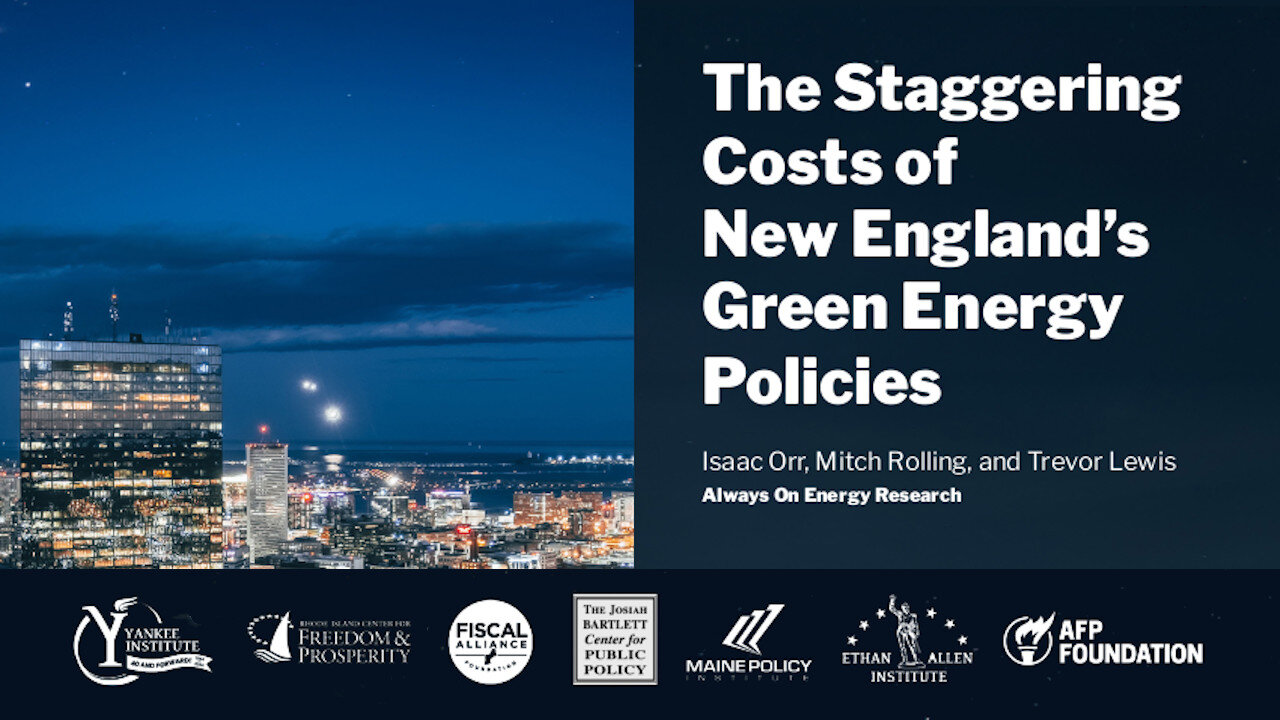Premium Only Content

PRESS CONFERENCE: THE STAGGERING COSTS OF NEW ENGLAND’S GREEN ENERGY POLICIES
With New England state governments committed to reducing their carbon emissions at least 80% by 2050, residents and businesses can expect electricity rates to double, along with rolling blackouts, according to a new joint report completed by several of the region’s leading think tanks. The study concludes that weather dependent “renewable” energies — like wind and solar — simply cannot meet regional demands for electricity.
Led by Always on Energy Research (AOER), a research organization dedicated to ensuring that every state in America has affordable, reliable energy, the report, The Staggering Costs of New England’s Green Energy Policies, was commissioned by the Americans for Prosperity Foundation, the Josiah Bartlett Center for Public Policy in New Hampshire, the Ethan Allen Institute in Vermont, the Fiscal Alliance Foundation in Massachusetts, the Maine Policy Institute, the Rhode Island Center for Freedom, and Prosperity, and Yankee Institute in Connecticut.
“Compliance with the New England Decarbonization Plans would cost $815 billion through 2050,” the report concludes. “New England families would see their electric bills increase by an average of $99 per year. Commercial businesses would see their costs increase by $489 per year. Industrial (manufacturing) customers would see their electric bills increase by an average of almost $5,280 per year.” The report shows that on a per-capita basis, the cumulative cost of the plans increases expenses for each person in New England by an additional $2,061 in 2030, $15,552 in 2040, and an additional $51,914 in 2050. All these increases will make New England more unaffordable.
Although the organizations support the goal of achieving a cleaner environment, the report finds that switching primarily to weather dependent “renewable” energy is not entirely feasible for the electrical grid of ISO-New England — an independent, not-for-profit corporation responsible for keeping electricity flowing across the six New England states. The study concludes that ISO-New England may be unable to coordinate electricity to power the region within 11 years, warning that “[i]f each of the New England states adheres to the same renewable-intensive path, a blackout scenario could be dire indeed.”
According to the study, powering New England without interruption during a year in which wind and sunshine are plentiful would require 225 gigawatts (GW) of renewables — or equivalent to power generated by 12,000 wind turbines and 129 million solar panels. Even more renewables would be required to power New England in a less sunny or windy year.
New England is responsible for less than 0.4% of global emissions; it is unclear just how much cleaner the environment will become in exchange for the costs that have been imposed on the region and its people.
Ultimately, the report finds that the cost of reducing carbon dioxide emissions under these plans exceeds the benefits of doing so, especially because in many cases, “green” policies have been enacted without any effort to quantify the environmental benefits they will secure. This raises the very real possibility that New England states are imposing net harm on their economies by imposing policies whose costs outweigh their benefits.
-
 9:49
9:49
Tundra Tactical
10 hours ago $17.39 earnedThe Best Tundra Clips from 2024 Part 1.
98.3K8 -
 1:05:19
1:05:19
Sarah Westall
10 hours agoDying to Be Thin: Ozempic & Obesity, Shedding Massive Weight Safely Using GLP-1 Receptors, Dr. Kazer
85.2K21 -
 54:38
54:38
LFA TV
1 day agoThe Resistance Is Gone | Trumpet Daily 12.26.24 7PM EST
62K11 -
 58:14
58:14
theDaily302
19 hours agoThe Daily 302- Tim Ballard
60.8K10 -
 13:22
13:22
Stephen Gardner
13 hours ago🔥You'll NEVER Believe what Trump wants NOW!!
109K300 -
 54:56
54:56
Digital Social Hour
1 day ago $11.17 earnedDOGE, Deep State, Drones & Charlie Kirk | Donald Trump Jr.
61.5K5 -
 DVR
DVR
The Trish Regan Show
14 hours agoTrump‘s FCC Targets Disney CEO Bob Iger Over ABC News Alleged Misconduct
66.1K39 -
 1:48:19
1:48:19
The Quartering
15 hours agoElon Calls White People Dumb, Vivek Calls American's Lazy & Why Modern Christmas Movies Suck!
147K112 -
 2:08:42
2:08:42
The Dilley Show
16 hours ago $37.19 earnedH1B Visa Debate, Culture and More! w/Author Brenden Dilley 12/26/2024
126K42 -
 4:55:59
4:55:59
LumpyPotatoX2
18 hours agoThirsty Thursday on BOX Day - #RumbleGaming
115K8